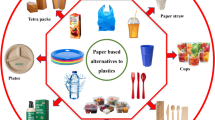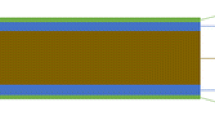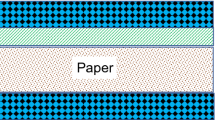Abstract
This paper presents an investigation on the enhancement of the barrier properties of paperboard and paper. Microfibrillar cellulose (MFC) and shellac were deposited on the fibre based substrates using a bar coater or a spray coating technique. The air, oxygen and water vapour permeability properties were measured to quantify the barrier effect of the applied coatings. In addition, the mechanical properties were determined and image analysis of the structure was performed to examine the coating adhesion. The air permeance of the paperboard and papers was substantially decreased with a multilayer coating of MFC and shellac. Furthermore, for the MFC and shellac coated papers, the oxygen transmission rate decreased several logarithmic units and the water vapour transmission rate reached values considered as high barrier in food packaging (6.5 g/m2 24 h). The analysis of mechanical and morphological properties indicated good adhesion between the coating and the base substrate.





Similar content being viewed by others
References
Andresen M, Stenius P (2007) Water-in-oil emulsions stabilized by hydrophobized microfibrillated cellulose. J Dispers Sci Technol 28(6):837–844
Andresen M, Johansson LS, Tanem BS, Stenius P (2006) Properties and characterization of hydrophobized microfibrilated cellulose. Cellulose 13:665–677
Appendini P, Hotchkiss JH (2002) Review of antimicrobial food packaging. Innov Food Sci Emerg Technol 3(2):113–126
ASTM F2622-08 (2008) Standard test method for oxygen gas transmission rate through plastic film and sheeting using various sensors. ASTM International, West Conshohocken, PA, USA. doi: 10.1520/F2622-08
ASTM Standard E96/E96 M-05 (2005) Standard test methods for water vapor transmission of materials. ASTM International, West Conshohocken, PA, USA. doi: 10.1520/E0096_E0096M-05
Bader HG, Goritz D (1994) Investigations on high amylose corn starch films. Part 2: water vapor sorption. Starch/Starke 46(7):249–252
Bandyopadhyay A, Ramarao BV, Ramaswamy S (2002) Transient moisture diffusion through paperboard materials. Colloids Surf A 206:455–467
Bley O, Siepmann J, Bodmeier R (2009) Protection of moisture-sensitive drugs with aqueous polymer coatings: importance of coating and curing conditions. Int J Pharm 378(1–2):59–65
Bruce DM, Hobson RN, Farrent JW, Hepworth DG (2005) High-performance composites from low-cost plant primary cell walls. Composite Part A 26:1486–1493
Chambliss WG (1992) Enteric coatings. In: Swarbrick J, Boylan JC (eds) Encyclopedia of pharmaceutical technology, vol 5. Marcel Dekker edition, New York, pp 189–200
Cherian BM, Pothan LA, Nguyen-Chung T, Mennig G, Kottaisamy M, Thomas S (2008) A novel method for the synthesis of cellulose nanofibril whiskers from banana fibers and characterization. J Agric Food Chem 56:5617–5627
Cockeram HS, Levine SA (1961) The physical and chemical properties of shellac. J Soc Cosmet Chem 12:316–323
Corte H (1982) Chapter nine. In: Rance HF (ed) Handbook of paper science, vol 2. Elsevier edition, Amsterdam, pp 11–75
Dufresne A (2006) Comparing the mechanical properties of high performances polymer nanocomposites from biological sources. J Nanosci Nanotechnol 6:322–330
Dufresne A (2008) Polysaccharide nano crystal reinforced nanocomposites. Canadian Journal of Chemistry Revue Canadienne de Chimie, 86, 484–494
Dufresne A, Dupeyre D, Vignon MR (2000) Cellulose microfibrils from potato tuber cells: processing and characterization of starch–cellulose microfibril composites. J Appl Polym Sci 76:2080–2092
Eilert SJ (2005) New packaging technologies for the 21st century. Meat Sci 71(1):122–127
Eriksen Ø, Syverud K, Gregersen Ø (2008) The use of microfibrillated cellulose produced from kraft pulp as strength enhancer in TMP paper. Nordic Pulp Paper Res J 23(3):299–304
Fang JM, Fowler PA, Escrig C, Gonzalez R, Costa JA, Chamudis L (2005) Development of biodegradable laminate films derived from naturally occurring carbohydrate polymers. Carbohydr Polym 60:39–42
Fukuzumi H, Saito T, Iwata T, Kumamoto Y, Isogai A (2009) Transparent and high barrier films of cellulose nanofibers prepared by TEMPO-mediated oxidation. Biomacromolecules 10:162–165
Garcıa MA, Martino MN, Zaritzky NE (1999) Edible starch films and coatings characterization: scanning electron microscopy, water vapor transmission and gas permeabilities. Scanning 21(5):348–353
Garcıa MA, Martino MN, Zaritzky NE (2000) Microstructural characterization of plasticized starch-based films. Starch/Starke 52(4):118–124
Gardner DJ, Oporto GS, Mills R, Samir MASA (2008) Adhesion and surface issues in cellulose and nanocellulose. J Adhes Sci Technol 22:545–567
Gatti A (2005) Risk assessment of micro and nanoparticles and the human health. In: Nalwa HS (ed) Handbook of nanostructured biomaterials and their applications in nanobiotechnology. Cellulose Scientific Publishers, Portland
Gontard N, Guilbert S, Cuq JL (1993) Water and glycerol as plasticizers affect mechanical and water vapor barrier properties of an edible wheat gluten film. J Food Sci 58(1):206–211
Hellén E, Ketoja J, Niskanen K, Alava M (2002) Diffusion through fibers network. J Pulp Paper Sci 28:55–62
Henriksson M, Berglund L (2007) Structure and properties of cellulose nanocomposite films containing melamine formaldehyde. J Appl Polym Sci 106:2817–2824
Henriksson M, Berglund LA, Isaksson P, Lindstrøm T, Nishino T (2008) Cellulose nanopaper structures of high toughness. Biomacromolecules 9(6):1579–1585
Hogan JE (1995) Modified release coatings. In: Cole G, Hogan JE, Aulton M (eds) Pharmaceutical coating technology. Taylor & Francis Books, London, pp 409–438
Iotti M, Fabbri P, Messori M, Pilati F, Fava P (2009) Organic-inorganic hybrid coatings for the modification of barrier properties of poly(lactic acid) films for food packaging applications. J Polym Environ 17(1):10–19
ISO 536 (1995). Paper and board—determination of grammage. International organization for standardization
ISO 5636-5 (2003) Paper and board—determination of air permeance and air resistance (medium range)—part 5: Gurley method. International organization for standardization
ISO 534 (2005) Paper and board—determination of thickness, density and specific volume. International organization for standardization
ISO 5269-1 (2005) Pulps: preparation of laboratory sheets for physical testing. Part 1: conventional sheet-former method. International organization for standardization
ISO 1924-2 (2008) Paper and board—determination of tensile properties—part 2: constant rate of elongation method. International organization for standardization
Khopade AJ, Jain NK (1990) A stable multiple emulsion system bearing isoniazid: preparation and characterization. Drug Dev Ind Pharm 24(3):289–293
Kjellgren H, Gällstedt M, Engström G, Järnström L (2006) Barrier and surface properties of chitosan-coated greaseproof paper. Carbohydr Polym 65:453–460
Lopez-Rubio A, Lagaron JM, Ankerfors M, Lindström T, Nordqvist D, Mattozzi A (2007) Enhanced film forming and film properties of amylopectin using microfibrillated cellulose. Carbohydr Polym 68(4):718–727
Lourdin D, Della Valle G, Colonna P (1995) Influence of amylase content on starch films and foams. Carbohydr Polym 27:275–280
Maiti S, Rahman S (1986) Application of shellac in polmers. J Macromol Sci Rev Macromol Chem Phys C26:441–481
Malainine ME, Mahrouz M, Dufresne A (2005) Thermoplastic nanocomposites based on cellulose microfibrils from Opuntia ficus-indica parenchyma cell. Compos Sci Technol 65:1520–1526
Mangan C (1998) The green chemical and polymers chain. European Commission, DG12, DG6, Luxembourg, Office for Official Publications of the European Union, Brussels
Nakagaito AN, Yano H (2005) Novel high-strength biocomposites based on microfibrillated cellulose having nanoorder-unit web-like network structure. Appl Phys A 80:155–159
Ougiya H, Watanabe K, Morinaga Y, Yoshinaga F (1997) Emulsion-stabilizing effect of bacterial cellulose. Biosci Biotechnol Biochem 61:1541–1545
Oza KP, Frank SGJ (1986) Microcrystalline cellulose stabilized emulsions. J Dispers Sci Technol 7:543–561
Pääkko M, Ankerfors M, Kosonen H, Nykänen A, Ahola S, Österberg M (2007) Enzymatic hydrolysis combined with mechanical shearing and high pressure. Biomacromolecules 8:1934–1941
Phan The D, Debeaufort F, Luu D, Voilley A (2008) Moisture barrier, wetting and mechanical properties of shellac/agar or shellac/cassava starch bilayer bio-membrane for food applications. J Membr Sci 325:277–283
Rogers CE (1985) Chapter two. In: Comyn J (ed) Polymer permeability. Elsevier edition, London, pp 11–75
Saettone MF, Perini G, Rijli P, Rodriguez L, Cini M (1995) Effect of different polymer-plasticizer combinations on ‘in vitro’ release of theophylline from coated pellets. Int J Pharm 126:83–88
Sandhya M (2009) Modified atmosphere packaging of fresh produce: current status and future needs. LWT Food Sci Technol 43(3):381–392
Syverud K, Stenius P (2009) Strength and barrier properties of microfibrillar cellulose (MFC) films. Cellulose 16(1):75–85
Tappi T 541om-99 (1999) Internal bond strength of paperboard (Z direction tensile). Tappi press, technology park, Atlanta, GE, USA
Tuil RV (2000) Converting biobased polymers into food packaging. In: Weber CJ (ed), Biobased packaging materials for the food industry: status and perspectives, a European concerted action. KVL publications, Copenhagen, pp 27–32
Turbak AF, Snyder FW, Sandberg KR (1983) Microfibrillated cellulose, a new cellulose product: properties, uses and commercial potential. J Appl Polym Sci Appl Polym Symp 37:815–827
Vasavada RC (1994) Shellac. In: Wade A, Weller PJ (eds) Handbook of pharmaceutical excipients. American Pharmaceutical Association publications, Washington D.C., pp 422–423
Wadia MS, Khurana RG, Mhaskar VV, Dev S (1969) Chemistry of lac-resin-1: Lac acids (part 1): Butolic, jalaric and laksholic acids. Tetrahedron 25:3855–3860
Williams GJ, Drummond JG (1994) Preparation of large section for the microscopical study of paper structure. In: Proceeding in 1994 papermakers conference. Tappi press, San Francisco, pp 517–523
Acknowledgments
The authors gratefully acknowledge Södra Cell, Dynea, Korsnäs Frövi, Peterson Linerboard, Elopak and the Research Council of Norway for funding. Furthermore, the authors wish to thank Gifu Shellac Co. Ltd. for the shellac and Nordic Paper Säffle for the base papers.
Author information
Authors and Affiliations
Corresponding author
Rights and permissions
About this article
Cite this article
Hult, EL., Iotti, M. & Lenes, M. Efficient approach to high barrier packaging using microfibrillar cellulose and shellac. Cellulose 17, 575–586 (2010). https://doi.org/10.1007/s10570-010-9408-8
Received:
Accepted:
Published:
Issue Date:
DOI: https://doi.org/10.1007/s10570-010-9408-8




